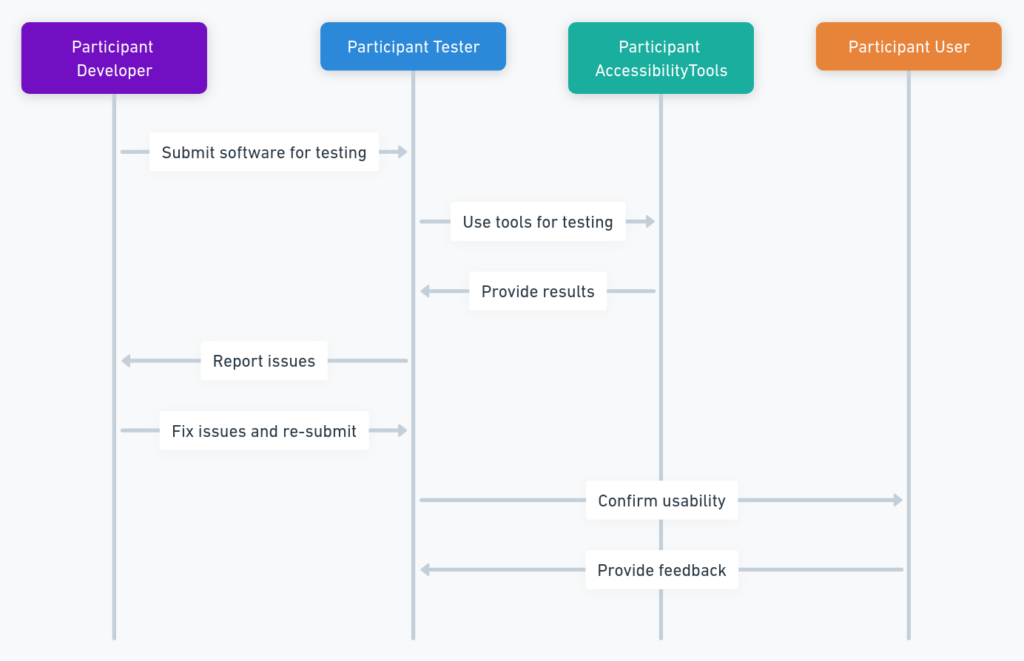Accessibility testing is a vital process that ensures websites and applications can be used by all users. This includes people with disabilities.
This testing evaluates the accessibility of a digital product based on a variety of criteria. It is designed to focus on those users who rely on assistive technology, such as screen readers, and on those with disabilities, including impaired vision, hearing or motor function.
It is important to identify and remove any barriers that may exist in a digital environment. This will allow all users to navigate, interact, and understand the content.
What is accessibility testing?
Accessibility testing is becoming a vital aspect in the world of web development and technology. It ensures that digital products can be used by all, including those with disabilities.
It is important to note that this type of testing does not only adhere to legal standards, but also embraces the moral responsibility of including all users.
ADA Compliance is a Must
The Americans with Disabilities Act requires that certain businesses make accommodations for those with disabilities. Content on the web must be accessible for those with hearing, cognitive, neurological and physical disabilities.
Testing accessibility ensures that the standards are being met and avoids any fines or legal consequences. This involves a variety of techniques and tools that ensure websites are readable, operable and understandable for all users.
Designing Inclusive Designs
It is all about designing experiences to accommodate as many people possible. It requires understanding the diversity of users and designing products for them.
Developers can eliminate any barriers to interacting with websites by conducting accessibility tests. This leads to innovative, universally-usable products.
Accessibility testing has many benefits

Accessibility testing not only ensures compliance but also inclusivity. It can improve the digital experience as well as enhance a brand’s reputation.
Enhance User Experience
Implementing accessibility features makes websites easier to navigate and interact with. This improves the user experience.
Features like text-to-speech conversion, keyboard friendly navigation, and color contrast could be included. A website that caters specifically to the user's needs will make them feel valued, and they are more likely return.
Enhancing Website Usability
Testing for accessibility can lead to an improvement in the usability of a site. Sites that are designed to be more accessible have clearer navigational cues, and simpler, intuitive layouts. All users benefit from these enhancements, not just those who have disabilities.
Reaching a wider audience
A website that is accessible opens the market up to individuals who may have previously been excluded because of disabilities. This increased number of users can result in higher traffic, more engagement and a wider audience for a website.
Accessibility can also boost SEO efforts, as search engines prefer websites with a high standard of usability.
Best Practices in Accessibility Testing
There are several best practices organizations can follow when launching accessibility testing to ensure that their website is accessible for all users including those with disabilities.
These practices are not only helpful in achieving ADA Compliance but also promote inclusive design.
Conducting Manual Tests
Manual testing is an important aspect of accessibility testing. Human testers evaluate the website or application in order to determine if it is usable by people with different disabilities.
The key activities are to ensure that the content can be read with screen readers and that interactive elements can be operated using a keyboard.
Also, users should have enough time to complete their tasks. To assess usability, testers simulate vision and mobility impairments.
Implementing Automated Tool
Automated tools can enhance manual testing by identifying issues which may have been overlooked. Automated programs can scan web pages for accessibility issues such as missing alt texts, incorrect ARIA roles or insufficient colour contrast.
These tools are a great way to quickly catch more technical compliance errors, which can be missed when testing manually.
User Testing and Feedback
A thorough accessibility test must also include feedback from actual users with disabilities. Organisations should conduct user testing sessions to gather feedback and understand the challenges faced by these users.
This direct feedback helps make adjustments and prioritize fixes which have the greatest impact on user experience.
Accessibility Tools
There are many tools that support accessibility testing and can identify and correct issues.
Screen Readers
Screen readers can be used to simulate the experience of visually-impaired users. Screen readers such as JAWS or NVDA should be used for testing the accuracy of textual and nontextual information.
Color Contrast Analyzers
Users with visual impairments need color contrast. The WebAIM Contrast Checker and the Paciello Group’s Colour Contrast Analyser are tools that help developers make sure foreground text and background colors meet accessibility standards.
This improves readability for those with color vision impairments.
Test your keyboard navigation
It is important to test the navigation of a site using only a computer keyboard. This testing method ensures that those who are unable to use a computer mouse can still navigate the website.
For keyboard navigation testing, tools and techniques include logical tab ordering, visible focus styles and accessible drop-down lists.
Common Accessibility Issues - How to Fix Them
Alt Text is not available for images
The absence of alternative text for images is one of the biggest accessibility barriers. Screen readers help visually impaired users to understand images.
These users are missing out on important information when images do not have alt text. Developers can help by ensuring that images have concise, descriptive alt text.
It's also important to avoid generic terms like "photo" or "image," and describe instead the image's content or purpose.
Inaccessible Forms
Many websites use forms for a variety of purposes, from signing up to receive newsletters to making purchases. If these forms aren't designed with accessibility as a priority, they can be a major obstacle.
Forms without the proper label tags are a common problem. Screen readers need them, as do users who don't use a computer mouse.
For improved accessibility, make sure that every form field is clearly labeled and supports keyboard navigation only. Validating input on forms can help users easily correct mistakes.
Non-Responsive Design
Users with disabilities can be adversely affected by a non-responsive web design, as it does not adjust to different screen sizes such as mobile devices.
Text can be difficult to read, and navigation may become difficult. Websites should use a responsive design, which adjusts the content layout according to screen size and orientation.
This adaptability improves not only accessibility, but also the overall experience of users across devices.
Non-Compliance with the Law has Legal Consequences
Businesses that fail to adhere to accessibility standards may face serious legal consequences. In many countries, such as the United States of America, legislation like the Americans with Disabilities Act mandates that digital services, including websites, be accessible to those with disabilities.
Non-compliance may lead to lawsuits and financial penalties as well as a damaged image. It is important to ensure accessibility because it not only demonstrates inclusivity, but also can increase the number of customers with disabilities.
Book a Demo and experience ContextQA testing tool in action with a complimentary, no-obligation session tailored to your business needs.
Conclusion
Accessibility testing benefits everyone. It is more than a legal requirement. Integrating accessibility testing into web-development processes allows organizations to ensure their products can be used by people of all abilities.
This inclusiveness increases user satisfaction, improves brand reputation and opens new market opportunities. Adhering to accessibility standards also protects businesses against legal risks that are associated with noncompliance.
Accessibility testing is crucial for a digital world that is fair and inclusive.
Also Read - How to test packaged applications?
We make it easy to get started with the ContextQA tool: Start Free Trial.
